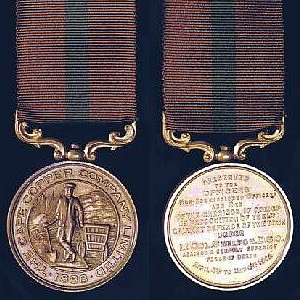Cape Copper Company Medal for the Defence of O'okiep
| Cape Copper Company Medal for the Defence of O'okiep | |
|---|---|
 |
|
| Awarded by the Cape Copper Company Limited | |
| Country |
|
| Type | Campaign medal |
| Eligibility | O'okiep Garrison members |
| Awarded for | Defence of the town during the Siege of O'okiep in 1902 |
| Campaign(s) | Second Boer War |
| Status | Unofficial |
| Statistics | |
| Established | 1902 |
| Total awarded | 18 Silver, 537 Bronze |
| Related |
|
|
Ribbon bar |
|
In the Colonies and Boer Republics which became the Union of South Africa in 1910, several unofficial military decorations and medals were instituted and awarded during the nineteenth and early twentieth century. The Cape Copper Company Medal for the Defence of O'okiep is a private campaign medal which was instituted by the Cape Copper Company Limited in 1902. The medal was awarded to members of the O'okiep Garrison who defended the town while it was besieged by Boer Commandos from 4 April to 4 May 1902, near the end of the Second Boer War.
The Cape Copper Company had its origin in the Cape Copper Mining Company, which was established in 1862 or 1863 as the Cape of Good Hope Copper Mining Company to take over the copper mining properties of Phillips & King, an enterprise which had been involved in copper mining around O'okiep in Namaqualand since the 1850s. The Cape Copper Mining Company was restructured as the Cape Copper Company in 1888.
The Cape of Good Hope was invaded by Boer commandos towards the end of the Second Boer War and the town Concordia, a few kilometres to the north of O'okiep, surrendered to Boer forces on 4 April 1902.
From 4 April to 4 May, the town O'okiep was besieged by the Boer forces under General Jan Smuts, whose strategy was to capture the rich copper fields and thus force the British to send troops from Cape Town to O'okiep, which would then leave Cape Town vulnerable to attack.
The garrison of O'okiep, commanded by Lieutenant Colonel W.A.D. Shelton DSO, consisted of some 900 men and included local miners who assisted Shelton's troops. The civilian defenders were mostly employees of the Cape Copper Company, three-quarters of whom were Coloured. A chain of blockhouses and other defensive positions had been prepared, and early in the siege the garrison succeeded in repulsing several determined attacks by the commando. However, when the departure of Smuts with a British safe-conduct to the deliberations at Vereeniging heralded the end of the war, the siege became little more than a good-humoured blockade.
On 1 May 1902, the commandos launched an attack on O'okiep, using the commandeered locomotive "Pioneer" of Concordia's Namaqua United Copper Company to propel a mobile bomb in the form of a wagon-load of dynamite into the besieged town. The protective defences at O'okiep consisted of a barbed wire fence, which was erected across the railway line at Braakpits Junction, just north of the town. The points at the junction were rigged to the fence, with the result that when the dynamite laden wagon breached the fence, it derailed at the points and spilled its load of dynamite on the ground, where it burned out harmlessly without exploding.
...
Wikipedia
